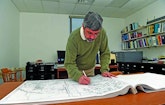
Tony Palamara is a lifelong resident of the central New York region where he now works.
The 58-year-old is also a 26-year veteran of the five-county water utility that serves the region. But he’s more than that — last year, he was recognized for his leadership as manager of water distribution for the Onondaga County Water Authority. And Palamara’s commitment to public service doesn’t stop there. He’s worked as a volunteer firefighter and for 18 years has served on the town board of the community where he grew up.
Over his tenure at the authority, he’s seen technological innovation, system consolidation and increased attention to safety as well as asset management. He takes it all in stride with a low-key style, but Palamara has a distinctive handle on the depth and breadth of the ever-growing system that he helps manage, according to his boss, Geoff Miller.
“Everyone can go to him because he understands our full system,” says Miller, deputy executive director of OCWA. “If there’s something odd going on in the water system, he’s the go-to guy. You go to Tony and you know you can find the answer there.” And with his experience as a volunteer firefighter and in town government, Miller adds, Palamara’s dedication seems limitless.
“He cares about all the Public Works.”
That helps explain why he was named statewide 2014 Professional Manager of the Year for Water Resources by the New York Chapter of the American Public Works Association.
Multi-county system
OCWA serves most of Onondaga County in central upstate New York, with the exception of the county’s largest city, Syracuse, which operates its own system. In addition, OCWA’s reach extends to four surrounding counties. Besides its own distribution lines, it operates additional water distribution lines under lease agreements with various local communities it serves.
OCWA gets its water from Lake Ontario and Otisco Lake, the easternmost of the Finger Lakes splayed across New York’s midsection. Ontario water is treated and resold to OCWA by the Onondaga County Metropolitan Water Board, accounting for about half of OCWA’s customers. The other half gets its water from the Otisco Lake supply, which OCWA treats at its own facility.
The region has seen substantial consolidation of water systems over the years, but OCWA’s area still includes a number of local village and township water utilities, many of whom buy water from the authority.
A changing business
OCWA’s water distribution system consists of a mix of cast iron pipelines, some dating back to the early 1900s, prestressed concrete pipe that came into use in the1960s, and more recent ductile iron pipe that has been in use since the early 1970s. Water drawn from the lakes is treated and held in massive covered concrete reservoirs.
The authority’s distribution network includes more than 2,000 miles of pipe served by 55 water tanks and 42 pump stations. “We’ve really grown a lot over the years,” Miller says. Through it all, Palamara has made it his business to keep up with the expanding system.
A native of the area, Palamara’s first career was in construction. In the 1980s he gravitated to Public Works, joining OCWA in 1990. The changes he’s seen since then have been enormous — from technology to changing regulations governing the water business. And then there’s the sheer growth of the system.
“We probably have twice as many customers and twice as many miles of water main as when I started,” Palamara says — although thanks to greater efficiency, the actual volume of water used each day isn’t much different.
Technological revolution
When he first joined OCWA in 1990, Palamara recalls seeing only one or two computers in the office. “Now most employees have laptops. They have access to data and can provide data.”
Add smartphones to the mix and workers in the field can tap into just about any information they need without having to return to the office to look it up.
For example, water system operators responding to customer concerns can collect data in the field and update the authority’s GIS system maps remotely instead of relying on paper maps of old.
Or take leak detection. Recording sensors deployed at key fire hydrants have played a role in helping pinpoint leak sources more accurately than ever, he notes — and by keeping track over time, can point to problems waiting to happen. And through it all, work crews never have to leave the field.
“We can take the hydrant recorder data, we can merge that into our existing data and we can look at trends to identify sources of water distribution problems in a timely fashion,” he says.
The crews who go on site to investigate “can transmit pictures directly from the field, so I can make decisions based on their observations without doing a site visit.”
Mobile office
With the power that technology puts in his crews’ hands, Palamara adds, OCWA took the logical next step — assigning wired-in leak detection crews who rarely have to come into the office.
“I had our leak detection crews set up with laptops, correlators, printers,” he says. “They are basically a mobile office. They spend most of their time in the field working, and they have direct access to the data that they would need” — a site’s history of repairs and other reports, for example.
Technology even speeds up the process when third-party contractors get involved. When a trouble spot needing repair pops up, information can be sent directly to the contractor. The bottom line is that service speeds up all the way down the line. “We can respond quicker,” Palamara says.
Asset management
Those changes aren’t just about new technology, though. They also reflect a bigger change in recent years: OCWA’s implementation of asset management. “Our goal is to do more preventive maintenance than emergency maintenance,” Palamara says.
According to Miller, Palamara has led the way in upgrading the authority’s asset and work management system, which is part of the SCADA system. OCWA has been busy recording every available detail and history of key pieces of system infrastructure. “That’s going to be valuable as employees retire,” Miller points out.
Twice a year, Palamara explains, the facility’s maintenance crew runs a report on the SCADA system to generate routine maintenance work orders. They record the completion of jobs, and the system helps monitor the workflow.
The system also allows flexibility. “When a crew is doing preventive maintenance, if they find a problem they can repair it as corrective maintenance,” Palamara says. That proactive stance reduces the need to call in crews after hours for emergencies.
An outside engineering firm conducts regular inspections of the system. The reports help measure performance and plan for future projects.
Team player
Palamara is a team player — a characteristic that extends not just to his co-workers but to the people who report to him. “He’s supported all his employees in their growth and development throughout the years,” Miller says. “He’s always eager to learn more. He’s always excelled at everything he’s done.”
He’s also been active in state and national professional groups, including the American Water Works Association and the American Public Works Association. Palamara has served on national committees for the AWWA, and has encouraged his staff to get involved in the organization locally.
And Palamara’s not shy about lending a hand with other water and wastewater agencies across the state. “There’s been a lot of consolidation over the years,” Miller says. “Tony’s helped lead that effort. He’s helped a lot of the communities in central New York get safe drinking water.”
Not content with just a day job, Palamara has been serving his local community, the Town of Lenox, as an elected member of the town council since 1998. And, he notes, he’s experienced valuable training in leadership and crisis management, particularly on the fire department, that has helped him on his day job.
Palamara had no idea he’d been nominated for the Professional Manager of the Year award. When he won, Jeff Brown, the OCWA general counsel and public information officer, delivered the news to him personally. “I was quite shocked,” Palamara says.
“It’s more about us as a group than it is about me as an individual. I’ve got a great group of 20 people who work directly with me.”
OCWA puts safety first
A 2014 award for the Onondaga County Water Authority’s distribution manager, Tony Palamara, may have been something of a harbinger.
In 2015, the authority was recognized for its safety practices by the New York Section of the American Water Works Association.
“Safety is job one in my book,” says Palamara — and the authority’s board has always been committed to safe work practices during his 26-year tenure with the organization.
Among other things, the award recognized OCWA for its active safety. The committee, with representatives from various departments in the authority, meets once a month, reviews safety concerns and accident reports, and makes recommendations on corrective measures. Employees can bring concerns directly to the committee, Palamara notes.
Two to three times a year — or more often if particular issues arise that need addressing — the authority holds special training events for employees.
Employee suggestions get listened to. Geoff Miller, deputy executive director of OCWA, points to one example — monthly safety posters that the committee issues to raise awareness among employees. The posters aren’t just generic, off-the-shelf pieces. They were generated in-house, with the help of a graphic artist on OCWA’s staff.
Miller notes that the original idea came from one of the employees in Palamara’s department.









